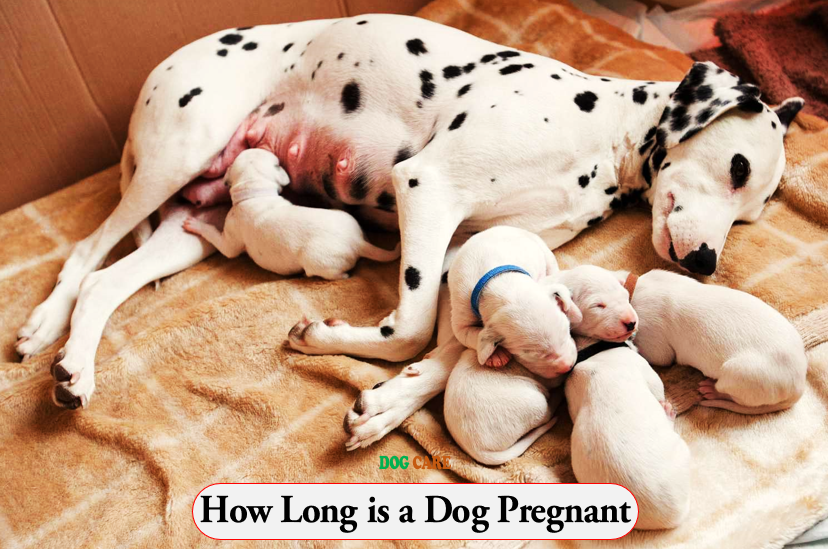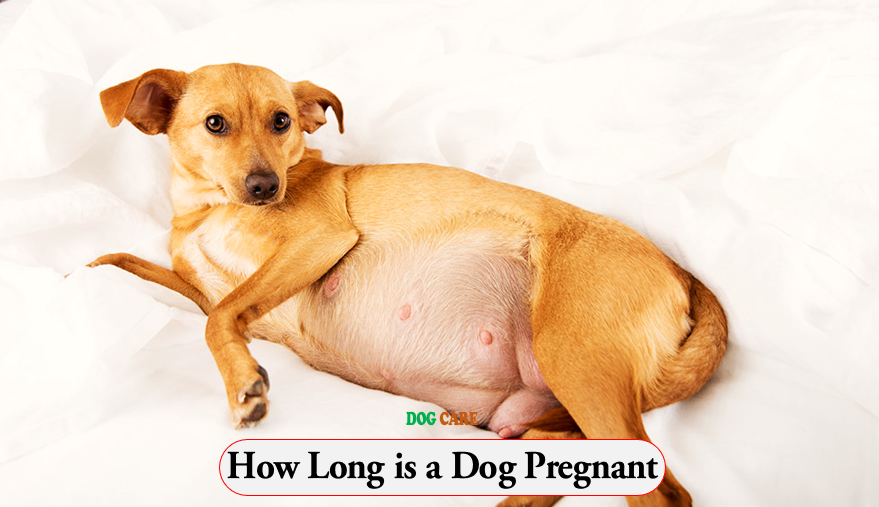How Long is a Dog Pregnant – A dog is pregnant for approximately 63 days. Dogs, like many other mammals, have a gestation period that lasts a specific length of time during which their embryos develop and grow inside the uterus.
For dogs, this pregnancy period typically ranges from 58 to 68 days, with the average being around 63 days. During this time, the female dog goes through various physiological and behavioral changes as she prepares for giving birth. Understanding the duration of a dog’s pregnancy is essential for dog owners and breeders to ensure proper care and support during this crucial period.
We will explore the different stages of a dog’s pregnancy, signs of imminent labor, and tips for providing the best possible care during this exciting time. So, let’s delve into the fascinating world of canine reproduction and discover what to expect when your dog is expecting.

Factors Affecting Dog Pregnancy
Dog pregnancy duration can be influenced by several factors, including the breed, size, and age of the dog. On average, dogs are pregnant for about 63 days, but this can vary depending on these factors. It’s important to consult with a veterinarian for accurate information and guidance during this time.
Factors Affecting Dog Pregnancy When it comes to understanding dog pregnancy, there are several factors that play a significant role in determining the duration of a dog’s pregnancy. These factors include the breed of the dog, the size of the dog, and the health and age of the dog.
Breed Of The Dog
The breed of the dog plays a crucial role in determining the length of their pregnancy. On average, most dog breeds have a pregnancy length of about 63 days. However, some breeds may have slightly shorter or longer pregnancies. For instance, small dog breeds such as Chihuahuas and Toy Poodles tend to have shorter pregnancies, lasting around 58-63 days. On the other hand, larger breeds like Great Danes and Saint Bernards may have pregnancies lasting up to 68-72 days. It’s important to note that these are general guidelines, and variations can occur within individual dogs of the same breed.
Size Of The Dog
The size of the dog can also impact the length of their pregnancy. Generally, smaller dogs have shorter gestation periods compared to larger dogs. This is because smaller dogs typically have smaller litters, and their bodies can accommodate the growth and development of puppies more efficiently. Larger breeds, on the other hand, have more space in their uterus, allowing for a longer pregnancy duration. It’s essential to consider the size of the dog when estimating the length of their pregnancy, keeping in mind that individual variation may occur.
Health And Age Of The Dog
The health and age of the dog are vital factors influencing the duration of their pregnancy. Just like humans, a dog’s health condition can affect the length of their pregnancy. Dogs in good health tend to have pregnancies that follow the expected timeline. However, if a dog has underlying health issues or complications during pregnancy, it can lead to a shorter or longer gestation period.
Additionally, age can also play a role in the length of a dog’s pregnancy. Younger dogs may have shorter pregnancies, while older dogs may experience longer pregnancies due to hormonal changes. Regular prenatal care and veterinary check-ups are crucial to ensuring a healthy pregnancy for the dog. In summary, the breed of the dog, size of the dog, and the health and age of the dog are essential factors that affect the length of a dog’s pregnancy. Understanding these factors can help dog owners and breeders estimate the expected duration and be prepared for the arrival of adorable puppies.
Length Of Dog Pregnancy
Understanding the length of dog pregnancy is crucial for dog owners and breeders alike. Just like humans, dogs go through a gestation period during which their bodies prepare to bring new life into the world. In this article, we will explore the average duration of dog pregnancy and the variations that can occur.
Average Duration
On average, a dog’s pregnancy lasts approximately 63 days from the time of conception, or fertilization. However, it’s important to note that this is just an average, and individual dogs may have shorter or longer gestation periods. Monitoring your dog closely during pregnancy is crucial to ensure her health and the health of the developing puppies.
Variations In Gestation Period
The duration of dog pregnancy can vary for several reasons. Factors such as the breed, age, and size of the dog can influence the length of gestation. Smaller dog breeds tend to have shorter gestation periods, typically around 58 to 63 days, while larger breeds may have longer pregnancies, ranging from 63 to 68 days.
It’s also important to consider that the timing of conception may not always be known with certainty. Dogs can experience multiple matings over a period of several days, and sperm can survive for up to seven days within the female reproductive tract. This makes determining the exact conception date a challenge.
Additionally, just like humans, every dog is unique. Some dogs may naturally have shorter or longer pregnancy durations without any underlying health concerns. However, if you notice any unusual symptoms or your dog exceeds 68 days of gestation without giving birth, it’s crucial to consult a veterinarian to ensure there are no complications.
In conclusion, the average duration of a dog’s pregnancy is around 63 days, but variations in gestation period are common. Monitoring your dog’s health and understanding the signs of labor are essential for supporting a smooth pregnancy and the delivery of healthy puppies.
Stages Of Dog Pregnancy
The duration of a dog’s pregnancy varies between 58 to 68 days, with an average gestation period of around 63 days. During this time, different stages of dog pregnancy can be observed, including the mating phase, implantation, embryonic development, and the final stage of labor and delivery.
Understanding the stages of dog pregnancy is crucial for any dog owner or breeder. It allows you to monitor and provide proper care to your pregnant dog, ensuring a safe and healthy pregnancy. Dog pregnancy is divided into three main stages: the early stage, middle stage, and late stage. Let’s take a closer look at each of these stages and what you can expect.
Early Stage
The early stage of dog pregnancy is the first few weeks after conception. During this period, it may be challenging to notice any visible changes in your dog’s physical appearance. However, there are some signs that can indicate pregnancy. These include changes in appetite, mild weight gain, and increased nipple size. It’s important to note that these signs can vary from dog to dog, so it’s crucial to consult a veterinarian for confirmation.
During the early stage, the fertilized eggs travel down the fallopian tubes and implant themselves into the uterus. This process is called implantation and marks the beginning of the growth of the puppies inside the womb. At this stage, it is advisable to start providing your pregnant dog with a balanced and nutritious diet to support healthy embryo development.
Middle Stage
The middle stage of dog pregnancy is when the puppies begin to grow rapidly. This stage typically occurs from the fourth to the sixth week of pregnancy. During this time, you may start to notice physical changes in your dog’s abdomen. Her belly will gradually enlarge as the puppies continue to grow. Additionally, you may observe an increase in your dog’s appetite as her body works to provide nourishment for both her and the developing puppies.
It is important to ensure that your pregnant dog gets regular veterinary check-ups during this stage. The veterinarian can perform an ultrasound to confirm the pregnancy and monitor the progress of the developing puppies. The middle stage is also the ideal time to start preparing a comfortable and safe whelping area for your dog to give birth.
Late Stage
The late stage of dog pregnancy is the final weeks leading up to labor and delivery. This stage typically occurs from the eighth week onwards. As the due date approaches, your dog’s abdomen will become noticeably larger, and she may experience more significant weight gain. You may also notice milk production from her nipples, which is a sign that she is preparing for nursing the puppies.
During the late stage, it is important to keep a close eye on your dog for any labor signs. These signs can include restlessness, nesting behavior, and a decrease in appetite. Be prepared with the necessary supplies such as clean towels, heating pads, and a contact number for your veterinarian in case of any complications during labor.
In conclusion, understanding the stages of dog pregnancy is vital for the well-being of both your pregnant dog and her puppies. By closely monitoring your dog’s progress and providing appropriate care at each stage, you can ensure a smooth and successful pregnancy journey.
Signs And Symptoms Of Dog Pregnancy
If you suspect that your dog might be pregnant, it’s important to look out for signs and symptoms that can confirm or rule out pregnancy. Knowing what to look for can help you provide the necessary care for your furry friend. In this article, we will explore the different signs and symptoms of dog pregnancy, including physical and behavioral changes that may occur during this exciting time.
Physical Changes
A dog’s body goes through a series of changes during pregnancy, some of which are visible. These physical changes can be a valuable indicator that your dog is pregnant and may include:
- Enlarged nipples: Around three weeks into pregnancy, a dog’s nipples may become larger and darker in color. This change is due to the increased blood flow in preparation for nursing puppies.
- Abdominal enlargement: As the pregnancy progresses, you may notice your dog’s abdomen becoming larger. This growth is a result of the developing fetuses and the expansion of the uterus.
- Weight gain: Pregnant dogs typically gain weight, especially in the later stages of pregnancy. It’s essential to consult with a veterinarian to ensure your dog is gaining an appropriate amount of weight.
- Vulvar swelling: In some cases, the vulva may swell during pregnancy, becoming more prominent than usual.
- Mammary gland development: As the pregnancy progresses, you may notice your dog’s mammary glands becoming more prominent or even producing milk.
Behavioral Changes
In addition to physical changes, pregnant dogs also exhibit behavioral changes that are worth noting. These behavioral changes may include:
- Increased affection: Some dogs may become more affectionate and seek more attention from their owners during pregnancy.
- Aloofness or aggression: On the other hand, some pregnant dogs may become more distant or even exhibit aggression towards other animals or people. These changes in behavior can be attributed to hormonal fluctuations.
- Nesting behavior: As the due date approaches, a pregnant dog may start exhibiting nesting behavior, such as searching for a comfortable spot, gathering and arranging soft items, or showing increased interest in her whelping box.
- Changes in appetite: Pregnant dogs may experience changes in appetite. Some dogs may eat less during the early stages of pregnancy, while others may develop an increased appetite.
- Restlessness: Restlessness can be a common behavioral change as a pregnant dog prepares for birth. Monitor your dog closely if you notice signs of restlessness, as labor can start soon.
Being aware of these physical and behavioral changes can help you determine whether or not your dog is pregnant. However, it’s crucial to consult with a veterinarian for an accurate diagnosis and to ensure the health and well-being of your pregnant dog.
Care And Preparation During Dog Pregnancy
During dog pregnancy, it is essential to provide proper care and make necessary preparations to ensure the health and well-being of both the mother and the puppies. From providing the right nutrition to regular vet check-ups and creating a comfortable whelping area, these are the key aspects to focus on.
Proper Nutrition And Diet
When it comes to dog pregnancy, proper nutrition plays a crucial role in the development of healthy puppies. Ensuring a balanced and nutritious diet is essential to meet the increased nutritional needs of the mother during this time. A diet rich in essential nutrients such as protein, calcium, and vitamins is vital for the mother’s health and the growth of strong and healthy puppies.
Here’s a list of key nutrients that should be included in the diet:
- Protein: To support the growth and development of the puppies.
- Calcium: To maintain strong bones and teeth.
- Fatty acids: For brain development and healthy skin and coat.
- Vitamins: To enhance the immune system and overall health.
- Minerals: Such as iron and zinc, to support healthy blood production and cell growth.
Consulting with a veterinarian to determine the specific dietary needs of the pregnant dog is highly recommended, as each dog’s requirements may vary depending on their breed, size, and overall health condition.
Regular Vet Check-ups
Regular visits to the veterinarian are essential during dog pregnancy to monitor the progress and address any potential health concerns. The vet will perform various examinations and tests to ensure the well-being of the mother and the developing puppies.
The vet check-ups include:
- Physical examination: The vet will assess the overall health of the mother, checking her weight, body condition, and vital signs.
- Ultrasound: This non-invasive procedure helps determine the number of puppies and their size, ensuring their proper growth.
- Blood tests: These tests are performed to check for any underlying health conditions or deficiencies that may require medical intervention.
By regularly visiting the vet and following their recommendations, potential complications can be identified early, allowing for appropriate treatment or adjustments to the care plan.
Creating A Comfortable Whelping Area
Preparing a comfortable and safe whelping area is crucial to provide a stress-free and secure environment for the mother and puppies during the birthing process. Here’s what you can do:
- Choose a quiet location: Select a secluded area away from high traffic or noise, ensuring a calm atmosphere for the mother.
- Provide bedding: Use soft and clean bedding material that is easily washable.
- Ensure temperature control: Keep the whelping area warm, between 75-85°F (24-29°C), to maintain the proper body temperature for the newborn puppies.
- Uninterrupted access to water and food: Make sure the mother has easy access to fresh water and a well-balanced diet throughout the whelping process.
Additionally, prepare a whelping box with high sides to prevent the puppies from wandering too far and provide a sense of security.
By taking these steps to create a comfortable whelping area, you can help the mother feel relaxed and ensure a safe environment for the upcoming birth.

Frequently Asked Questions On How Long Is A Dog Pregnant
How Many Months Do A Dog Stay Pregnant?
A dog stays pregnant for approximately nine weeks, or about two months.
How Long After Mating Can You Tell A Dog Is Pregnant?
A dog can be confirmed pregnant through ultrasound as early as 4 weeks after mating.
How Do You Know When A Dog Is Done Giving Birth?
You’ll know when a dog is done giving birth when all the puppies have been delivered and the contractions and pushing have stopped.
How Many Times Can A Dog Get Pregnant In A Year?
Dogs can get pregnant once or twice a year, depending on their reproductive cycle.
Conclusion
Understanding how long a dog is pregnant is essential for dog owners and breeders alike. By knowing the average gestation period and monitoring the signs of pregnancy, you can ensure the health and well-being of both the mother and her puppies.
Remember to consult with a veterinarian for expert guidance throughout this exciting journey. With proper care and attention, you can help ensure a successful and smooth pregnancy for your furry friend.


